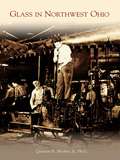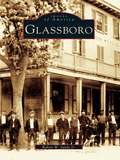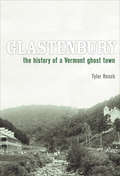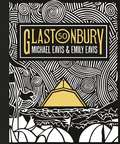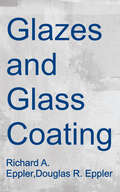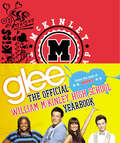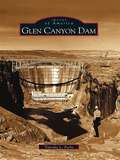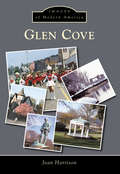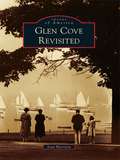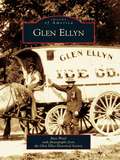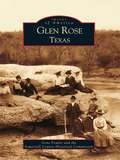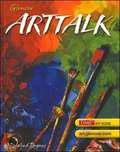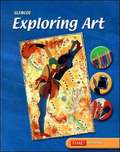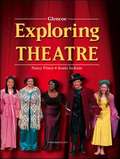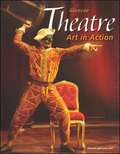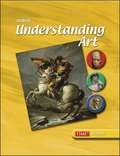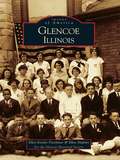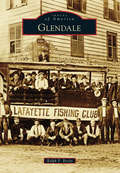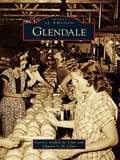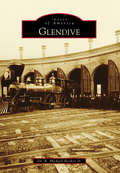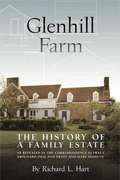- Table View
- List View
Glass Painting
by Diana FisherThe beauty of stained glass has been capturing imaginations since the first medieval artists created cathedral windows. Until recently, colored glass creations involved specialized training and equipment. Now there is a new generation of easy-to-use glass paints available that produce lasting works of art with the same vivid, lustrous colors you find in stained glass. In this book, the author shows you in detail how to create your own stunning pieces in a variety of styles and techniques.
Glass in Northwest Ohio
by Quentin R. Skrabec Jr.The discovery of natural gas around Findlay in 1886 started an industrial rush in northwest Ohio. Within five years, over 100 glass companies had moved into the region for free gas and railroad connections to the western markets. Unfortunately the gas ran out in just a few years, and many glass companies moved on, but those that stayed changed the nature of the glass industry forever. A brilliant inventor, Michael Owens of Libbey Glass automated the glass-making process after 3,000 years of no change. His automated bottle-making machine changed American life with the introduction of the milk bottle, beer bottle, glass jar, baby bottle, and soda bottle. It also eliminated child labor in the glass factories. Owens also automated the production of fl at glass by 1920. By 1930, over 85 percent of the world's glass was being produced on the machines of Michael Owens, bestowing the title of "Glass Capital of the World" upon northwest Ohio.
Glassboro (Images of America)
by Robert W. Sands Jr.Glassboro is the first illustrated history of the community whose name pays tribute to the industry that made it what it is today. Filled with treasured memories, the book preserves a remarkable collection of vintage photographs that capture historic Glassboro in the past two centuries as a booming southern New Jersey community at the height of its glass industry. The pages are filled with never-before-published images of the Whitney Glass Works, the Warrick-Stanger Glass Works, the Glassboro Auditorium, the Palace Theatre, and other landmarks from long ago.
Glasshouses
by Fiona GrantThe orangeries and glasshouses that stand in the gardens of many stately homes help to tell a three-century story of garden fashion. They reflect both the architectural and social trends of their time, but above all show an increasing ability to tailor the buildings to the needs of the plants within. Starting with the Restoration fashion for cultivating pineapples, oranges and bananas within palatial orangeries, Fiona Grant then explains the development of glasshouses through the eighteenth century into the heyday of diversification and specialisation that charaterized the Victorian period, to the eventual decline of great glasshouses after the First World War. The role of the glasshouse as a display of status and of an interest in botany, technology and architecture is explored, and the book is colorfully illustrated throughout.
Glastenbury: The History of a Vermont Ghost Town (Brief History Ser.)
by Tyler ReschThe curious history of a tiny town that all but disappeared . . . Includes photos! Founded by a famously scheming New Hampshire governor, Glastenbury struggled for over a century to break triple digits in population. A small charcoal-making industry briefly flourished after the Civil War, yet by 1920 Glastenbury counted fewer than twenty inhabitants. The end came officially in 1937, when the state, following a spirited debate, formally disincorporated the town. Yet Glastenbury&’s legacy lives on in Tyler Resch&’s lively and amusing history. Follow Resch as he chronicles the community&’s compelling, if always precarious, existence. From mysterious murders and curious development schemes to the township&’s eventual annexation by the US Forest Service, Glastenbury tells the ultimately redemptive tale of a community that lost its political status, only to gain a national forest.
Glastonbury 50: The Official Story of Glastonbury Festival
by Emily Eavis Michael EavisTHE SUNDAY TIMES BESTSELLERA BOOK OF THE YEAR PICK IN THE TIMES: 'Captivating'A ROUGH TRADE BOOK OF THE YEAR: 'In-depth and inspiring''Beautifully compiled ... the perfect festival experience' SUNDAY TIMESGlastonbury 50 is the authorised, behind-the-scenes, inside story of the music festival that has become a true global phenomenon. The story begins in 1970. The day after Jimi Hendrix's death... dairy farmer Michael Eavis invites revellers to his field in Somerset to attend a 'Pop, Folk & Blues' festival. Tickets are £1 each, enticing more than a thousand customers with the promise of music, dance, poetry, theatre, lights and spontaneous entertainment - as well as free milk from his own Worthy Farm cows.Fast forward through five tumultuous decades and the Eavis's vision now encompasses a gigantic 'city in the fields', with a total annual population nearing a quarter of a million. Tickets sell out within minutes, the show is beamed live to more than 40 countries around the globe, and over 3 million people are registered to attend. Meanwhile, the bill has expanded to include big name performers, artists and designers from every branch of the creative arts. Glastonbury Festival is now the largest outdoor green fields event in the world.In their own words, Michael and Emily Eavis reveal the stories behind the headlines, and celebrate 50 years of history in the Vale of Avalon. They're joined by a host of big-name contributors from the world of music - among them Adele, JAY-Z, Dolly Parton, Chris Martin, Noel Gallagher, Lars Ulrich and Guy Garvey. They're joined by artists - Stanley Donwood, Kurt Jackson and many more. Writers - Caitlin Moran, Lauren Laverne, Billy Bragg - and by a host of photographers, from Seventies icon Brian Walker to rock and roll legends Jill Furmanovsky and Greg Williams.Together they bring you the magic that makes Glastonbury, Glastonbury.
Glastonbury 50: The Official Story of Glastonbury Festival
by Emily Eavis Michael EavisTHE SUNDAY TIMES BESTSELLERA BOOK OF THE YEAR PICK IN THE TIMES: 'Captivating'A ROUGH TRADE BOOK OF THE YEAR: 'In-depth and inspiring''Beautifully compiled ... the perfect festival experience' SUNDAY TIMESGlastonbury 50 is the authorised, behind-the-scenes, inside story of the music festival that has become a true global phenomenon. The story begins in 1970. The day after Jimi Hendrix's death... dairy farmer Michael Eavis invites revellers to his field in Somerset to attend a 'Pop, Folk & Blues' festival. Tickets are £1 each, enticing more than a thousand customers with the promise of music, dance, poetry, theatre, lights and spontaneous entertainment - as well as free milk from his own Worthy Farm cows.Fast forward through five tumultuous decades and the Eavis's vision now encompasses a gigantic 'city in the fields', with a total annual population nearing a quarter of a million. Tickets sell out within minutes, the show is beamed live to more than 40 countries around the globe, and over 3 million people are registered to attend. Meanwhile, the bill has expanded to include big name performers, artists and designers from every branch of the creative arts. Glastonbury Festival is now the largest outdoor green fields event in the world.In their own words, Michael and Emily Eavis reveal the stories behind the headlines, and celebrate 50 years of history in the Vale of Avalon. They're joined by a host of big-name contributors from the world of music - among them Adele, JAY-Z, Dolly Parton, Chris Martin, Noel Gallagher, Lars Ulrich and Guy Garvey. They're joined by artists - Stanley Donwood, Kurt Jackson and many more. Writers - Caitlin Moran, Lauren Laverne, Billy Bragg - and by a host of photographers, from Seventies icon Brian Walker to rock and roll legends Jill Furmanovsky and Greg Williams.Together they bring you the magic that makes Glastonbury, Glastonbury.
Glazes and Glass Coatings
by Richard A. Eppler Douglas R. EpplerCurrent advances in the formulation and chemical aspects of glazes and glass coatings make this comprehensive resource the most up-to-date reference on glazes for the ceramics industry. By focusing on the process of making ceramic coatings, their chemical makeup, and the properties of these coatings, Glazes and Glass Coatings is a book that will appeal to a wide-ranging audience from industries involved in the manufacturing of tile, ceramic coating materials, sanitaryware, tableware, enameled appliances, hobby and giftware to faculty and students in ceramic engineering, to studio potters. Anyone interested in making or using glazes and glass coatings will value the expertise and wealth of knowledge presented authors by Eppler & Eppler.
Glee: The Official William McKinley High School Yearbook
by Debra Mostow Zakarin The Creators of GleeStraight from Lima, Ohio, The Official William McKinley High School Yearbook is a full-color, completely up-to-date book that captures all the memories of seniors like Rachel Berry, Kurt Hummel, Finn Hudson and their fellow Gleeks. Featuring tons of glossy photos and exclusive images, the one and only OFFICIAL Glee yearbook will transport you to the halls of William McKinley High School. Just be sure to watch out for slushies!
Glen Canyon Dam
by Timothy L. ParksConstructed between 1956 and 1966 by the United States Bureau of Reclamation, Glen Canyon Dam on the Colorado River was a project of immense proportions. Even before the non-stop pouring of 5 million yards of concrete began, much work had to be accomplished. The town of Page, Arizona was established on a windswept mesa to house workers and their families, and the 1,028-foot Glen Canyon Bridge was built to carry men, materials, and equipment to the dam site. Though the dam has proven a controversial structure throughout its history, the massive undertaking of its construction was an undeniable triumph of ingenuity and determination.
Glen Cove
by Joan HarrisonGlen Cove, the only city located on Long Island's Gold Coast, has long been reinventing itself. After World War II, the farms and estates in the area gave way to suburban development. Modern advancements like the zoom lens, the dimmer switch, and X-ray technologies were all developed within the city limits, while factories on the creek supplied the world with carbon paper, typewriter ribbons, and graphic arts film and cameras. Albert Einstein, Nikita Khrushchev, and the Kennedy families stayed in the community, and stars of stage and screen performed about town. In 1968, Glen Cove celebrated its tricentennial. It was followed by urban renewal and the rebuilding of the old downtown. In the final years of the 20th century, the industrial era ended, and under the auspices of Mayor Thomas Suozzi, environmental cleanup and waterfront revitalization began.
Glen Cove Revisited (Images of America)
by Joan HarrisonSince its founding in the late 17th century as a mill town, Glen Cove has been simultaneously rural and industrial, patrician and working class. A city of multiple ethnicities and close family ties, Glen Cove has been home to generations of immigrants who came to work and stayed to live, as well as to the children of America's elite who built their summer homes on the shores of Hempstead Harbor. In Glen Cove Revisited, "The Heart of the Gold Coast" is seen as only insiders know it, through images of the mill ponds and barnyards, estates and factories, schools and neighborhoods, and the people, famous and unknown, which make up this microcosm of America.
Glen Ellyn (Images of America)
by Russ Ward Glen Ellyn Historical SocietyGlen Ellyn took its name from a Victorian real estate development whose massive promotional campaigns brought this unusually beautiful village to the attention of city dwellers eager to move their families away from the grimy, coal-fired environs of Chicago. Its story begins with hardy New Englanders who felled trees to build log cabins, broke the virgin prairie sod, and trapped wild game in the marshlands that would become greater Chicago, continuing through the radical changes that came with the railroad and the Civil War. From Potawatomi Indians and pioneers to an important Underground Railway station; from a luxurious lakeside health resort with a fabulous grand hotel to one of Chicago's premier suburban communities, Glen Ellyn presents the village's rich history with evocative photographs from the collection of the Glen Ellyn Historical Society.
Glen Rose, Texas (Images of America)
by Gene Fowler Somervell County Historical CommissionCharles Barnard, a Connecticut entrepreneur, settled in the Brazos Valley in 1849, running an Indian Trading Post. He built a gristmill in 1860 near the confluence of the Brazos and Paluxy Rivers, around which the town of Glen Rose sprang up. Captured here in over 200 vintage photographs and postcards is the history of this quintessential little Texas town, from its origins as a mill town, to the bedroom community of Fort Worth that it has become today. In its earliest days, settlers flocked to the region from the war-torn South during the Civil War. By the 1900s, both Somervell County and Glen Rose established fame as a tourist resort, offering springs and artesian waters to heal the body and spirit. Naturopathic and magnetic healers built sanitariums, while locals built tourist parks to entertain the crowds that came for rest and relaxation. Showcased here are images of the Hill postcard collection, which relay the intriguing story of Glen Rose as a recreation mecca, the Moonshine Capital of Texas during Prohibition, the discovery of the infamous dinosaur tracks, and its development as it enters the 21st century.
Glencoe ArtTalk (4th Edition)
by Rosalind RagansGlencoe ArtTalk has expanded its coverage of art history, strengthened its technology integration features, and placed more emphasis on the performing arts - all while maintaining its focus on a media approach to the elements and principles of art. ArtTalk integrates lessons in Perception, Creative Expression, Historical and Cultural Heritage, and Evaluation to form a comprehensive approach to art that helps every student - regardless of their learning style - think more creatively, make better decisions, even learn the art of self discipline.
Glencoe Exploring Art
by Mcgraw-Hill Staff Rosalind Ragans Gene MittlerA media approach that builds art appreciation Exploring Art gives students insights into the ways artists are inspired, and the reasons they choose particular media to realize their artistic visions. From drawing and painting to architecture, graphic design, and photography, the chapters interweave compelling lessons on elements and principles of art, art history, and criticism with opportunities for studio production.
Glencoe Exploring Theatre
by Nancy Prince Jeanie JacksonExploring Theatre focuses on the development of the total student, which includes developing personal resources, self-confidence, the ability to work well with others, and a life-long appreciation of theater; learning to bolster self-concepts, build an ensemble, observe people and places more closely, move expressively, and become more aware of the senses; learning basic acting skills such as improvisation, characterization, role preparation, and stage movement; exploring a range of career or avocational opportunities in theater and theater education; understanding the various aspects of the production process; and studying special topics such as storytelling, clowning, oral interpretation, readers theater, and puppetry. This text is an ideal introductory theater text for both middle and high school.
Glencoe Mill Village (Images of America)
by Don BoldenThe Glencoe Cotton Mill and its village have a story very similar to that of other 19th- and 20th-century mill communities across the South. The mill operated from 1880 until 1954, and its employees lived in mill houses and shopped at the company store. After it closed, the community faded into vacant houses, rutted streets, and weed-covered properties. Unlike other mills, however, Glencoe found a spark of new life. People interested in its history--headed by Graham resident Sarah Rhyne--joined together to see the property declared a national historic site. Work reclaimed the mill and preserved it for the future. Preservation North Carolina helped, as did a number of individuals from the area, and life returned. Many of the mill houses have been purchased and restored and are now home to a new generation of residents. The Textile Heritage Museum occupies the old office-store building and, with its displays, shows the history of Glencoe and southern textiles in general.
Glencoe Theatre: Art in Action
by Robert D. Strickland Robert D. TaylorTheatre: Art in Action teaches theater through hands-on performance-based exercises that have students assume the roles of actor, director, designer, technician, producer, stage crew, publicist, etc., to gain an appreciation for and understanding of theater as an art form, today and through history.
Glencoe Understanding Art
by Rosalind Ragans Gene MittlerA Journey through the stimulating history of art. With this chronological/historical approach to art, your students will understand how historical, political, geographical, social, and religious events shape each culture's art and makes it unique. The traditions of Western Europe are examined along with those of China, Japan, India, Native America, and Africa.
Glencoe, Illinois
by Glencoe Historical Society Ellen Kettler Paseltiner Ellen ShubartGlencoe, Illinois, "Queen of Suburbs," has long been heralded as an idyllic place to live. Situated on Lake Michigan in the heart of Chicago's North Shore, Glencoe was first settled in 1835 by Anson Taylor, a young storekeeper. Glencoe began to thrive thanks to one of its famous early residents, Walter Gurnee, president of the Chicago and Milwaukee Railroad. Gurnee moved to Glencoe in the mid-1850s and in 1855 established a railroad stop across the street from his home. His presence accounts for the town's accessibility and nucleus, but it was the vision of Dr. Alexander Hammond, who arrived in Glencoe in 1867, that helped to shape it into the model suburban town it has become. It is the people of the past and present who are at the heart of this community. This collection of over 200 images captures the heart and spirit of this all-American suburb, from the village's founding and early history as a farming community and utopian settlement to the annual Fourth of July parades that continue to trumpet through the town's center.
Glendale
by Ralph F. BradyGlendale, New York, lies just six miles from the center of the bustling metropolis of New York City but has always managed to retain its rural charm since its beginning. Taking its name from Glendale, Ohio, the town began with the unlikely occurrence of a piece of land changing hands in payment of a debt in the mid-1800s. Development of the land was slow in comparison to the surrounding communities, and many of the unoccupied parcels were bought up by people interested in building picnic parks and other types of recreational areas. Around that same time, a New York state law banned the construction of any more cemeteries in Manhattan, so Glendale's available land became equally attractive for this type of development. Glendale takes a journey back in time to the picnic parks, German biergartens, and early industries that took this community far from its origins as a farming town.
Glendale (Images of America)
by Carol J. St. Clair Charles S. St. ClairEstablished in 1892, nine miles northwest of Phoenix in the Salt River Valley of Arizona, Glendale at first attracted farmers with strong Protestant religious convictions. Soon, however, others began to settle in the town and on the rich farmlands of the area. Although predominantly Anglos, the settlers that came in the latter 1890s and early decades of the 1900s included various ethnic minorities. Each group had a significant role in the city's development into an important agricultural center that shipped produce all over the country. World War II and its influx of servicemen to train at Glendale's Luke and Thunderbird airfields brought permanent changes to Glendale. The population doubled and doubled again and again. Today the city-Arizona's fourth largest-is a metropolitan area of 59 square miles and close to 250,000 people. This volume offers windows to understanding the growth and development of Glendale over the years.
Glendive (Images of America)
by Dr R. Booker JrGlendive was founded in the early 1880s, and its growth was promoted and sustained by the Northern Pacific Railroad. Legend holds that Sir George Gore, on a hunting expedition with famed mountain man Jim Bridger, named a creek in the area Glendale Creek after a similar one in his native County Donegal, Ireland. Over the years, the word "Glendale" somehow transformed into "Glendive." Prior to the arrival of European Americans, indigenous peoples, including the Crow and the Lakota Sioux, called the area home. The arrival of the Northern Pacific in 1881, along with the passage of the Enlarged Homestead Act in 1909, lured people from America and abroad to this isolated region to pursue their version of the American dream.
Glenhill Farm: The History of a Family Estate, as Revealed in the Correspondence Between Brognard Okie and Ernst and Mary Behrend
by Richard L. HartBy 1930, having developed a highly successful business, the innovative paper manufacturer Ernst Behrend and his wife Mary purchased a number of existing houses and farms to give them sufficient acreage to create a large estate. In 1948 this property became a campus of Penn State University. Known as Penn State Behrend, to this day it retains the original buildings at the historic center of the campus.Based on archival materials, including copious letters between the Behrends and their Philadelphia architect, R. Brognard Okie, this book recounts the planning and development of a unique residence as the country headed into the Great Depression. Letters between the key figures give the reader a glimpse into their thoughts and concerns, including the selection of an architect, the choice of an architectural style, issues involved in planning the estate, and the features and design of the buildings that were constructed or modified. Vintage and modern photographs help convey the nature of the buildings that Okie designed as well as a sense of the Behrends’ lifestyle in the 1930s.An absorbing microhistory of what is now Behrend College, Glenhill Farm provides a window onto a period when new money from industry supported lavish lifestyles, and it reveals how this particular project, conceived and constructed during the Great Depression, was affected by its extraordinary economic circumstances.

